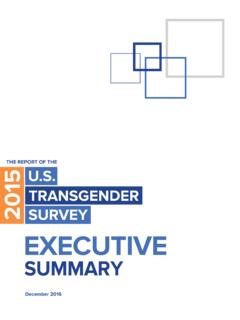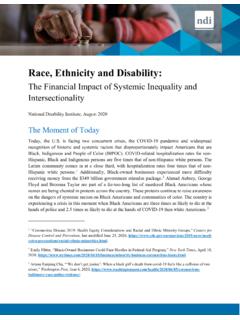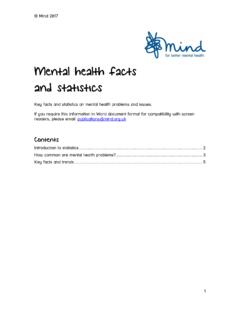Transcription of Fact Sheet | Homelessness in Canada and Ontario
1 Page 1 Fact Sheet | Homelessness in Canada and Ontario Lack of adequate and affordable housing places low-income and vulnerable populations at risk of Homelessness . Who is experiencing Homelessness in Canada ? 35,000 Canadians are homeless on a given night. At least 235,000 Canadians experience Homelessness in a year. o 27% are women o 19% are youth The number of adults 55+ years old experiencing Homelessness is rising a combined 24% of shelter users. o 28-34% of the shelter population is Indigenous. o Indigenous people are overrepresented amongst the homeless population in virtually all urban centres in Canada . In addition to the visibly homeless, 450,000 900,000 Canadians represent the hidden homeless. Hidden Homelessness is defined as people who live temporarily with others but without guarantee of continued residency or immediate prospects for accessing permanent housing.
2 O This describes people staying with relatives, friends, neighbours or strangers because they have no other option. In 2014, approximately million Canadians (representing 8% of the overall population aged 15 and over) reported that, at some point in their life, they had to temporarily live with family, friends, in their car, or anywhere else because they had nowhere else to live. Page 2 o More than one half (55%) of those who had experienced hidden Homelessness were in this situation from one month to less than one year. o About 1 in 5 (18%) experienced it for a year or more. Those who reported an Indigenous identity were more than twice as likely (18%) to have experienced hidden Homelessness as their non-Indigenous counterparts (8%). Out of the million Canadians aged 15 and over who reported having a disability, 13% also reported having experienced hidden Homelessness (compared with 6% of Canadians without a disability).
3 people on social housing waiting lists are at higher risk of Homelessness . The 2016 ONPHA waiting lists survey reported that 171,360 households were on social housing waiting lists in Ontario as of the end of December 2015. Homelessness has significant costs for cities and taxpayers: Poor housing and Homelessness is costly for cities and taxpayers. o The average monthly costs of shelter beds are $1,932, almost ten times higher than the average monthly cost of social housing of $ In addition, homeless people and those poorly housed have a higher rate of illness. o The monthly cost of a hospital bed is $10,900. The State of Homelessness reports that the annual cost of Homelessness to the Canadian economy is $ billion dollars. Preventing eviction is often the most effective way to prevent Homelessness . A survey of more than 200 tenants accessing Tenant Duty Counsel Program ((TDCP) services in Toronto, Ottawa, and Hamilton found that 2 out of 3 tenants Page 3 surveyed had been homeless in the past.)
4 50% of all tenants surveyed had stayed at someone else s place because they had no home of their own. 43% had left their home because it wasn t safe for them. 31% had spent time at a shelter. 24% had slept outside, or in a place not meant for human habitation. The eviction of vulnerable tenants into Homelessness is a systemic problem. A diversion program at the Landlord and Tenant Board, similar to diversion programs in the criminal justice system, would serve to prevent evictions into Homelessness by connecting tenants and landlords with necessary supports. Tenants across the province could also benefit from access to financial support for preventing eviction and stabilizing housing. Housing stabilization funds would provide simple and transparent eligibility criteria, application process, and appeal mechanism, would help prevent evictions into Homelessness .





